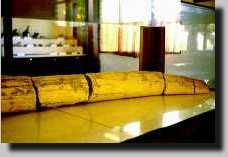
 In
the year 1887 a young Dutchman named Eugene Dubois left the Netherlands
on a ship bound for the East Indies. Born in 1858, Dubois had
spent seven years studying medicine at the University of Amsterdam
before taking up a teaching post there. His chief interest. however,
was the evolution theory which had been proposed In
the year 1887 a young Dutchman named Eugene Dubois left the Netherlands
on a ship bound for the East Indies. Born in 1858, Dubois had
spent seven years studying medicine at the University of Amsterdam
before taking up a teaching post there. His chief interest. however,
was the evolution theory which had been proposed
by Charles Darwin some years earlier. Convinced that the most
likely places to find fossilized remnants of mankind's early
ancestors lay in tropical zones, Dubois quit his job at the university
and joined the Dutch Colonial Army as a medical officer
Arriving first in Sumatra, he was able to obtain financial support
from the army and began excavating in a number of caves. Initial
results, however, proved disappointing, since the fossils he
discovered were too young to yield evidence of the 'missing link'
for which he was searching. . Then he heard news of some exciting
discoveries being made by van Rietschoten in the Wajak Mountains
near Tulungagung in East Java. Moving from Sumatra, Dubois turned
his attention to the region of Ngawi and in 1891 unearthed his
first significant evidence, a skull cap and upper jaw molar.
on the banks of the Solo River at Trinil. He attributed the fossils
to a type of ape which he named Anthropopit hecus. But eleven months
later, in August 1892, he discovered a femur on the same level
as the previous year's finds, which appeared to prove that the
creature had walked upright. As a result, Dubois concluded that
what he had found was an 'upright walking ape-man'. which he
named Pithecanthropus Erectus. The article which Dubois
was to publish in 1894, claiming that Pithecanthropuswas a
distant ancestor of modern man and had lived almost a million
years ago. caused such an outcryamong the scientific community
as well as the religious orthodoxy that he ended up re-burying
his discoveries under his own house,where they remained for the
next thirty years. hecus. But eleven months
later, in August 1892, he discovered a femur on the same level
as the previous year's finds, which appeared to prove that the
creature had walked upright. As a result, Dubois concluded that
what he had found was an 'upright walking ape-man'. which he
named Pithecanthropus Erectus. The article which Dubois
was to publish in 1894, claiming that Pithecanthropuswas a
distant ancestor of modern man and had lived almost a million
years ago. caused such an outcryamong the scientific community
as well as the religious orthodoxy that he ended up re-burying
his discoveries under his own house,where they remained for the
next thirty years.
|

